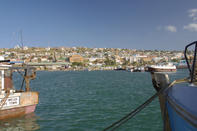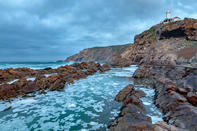Bay of Mussels
The name Mossel Bay is derived from the Dutch for Bay of Mussels. One account has it that explorer Cornelis de Houtman gave Mossel Bay its name after stopping there in 1595.

Another account claims that Dutch Admiral Paulus van Caerden gave this place its name on stepping ashore in 1601. Going back much further into Mossel Bay’s history, it is interesting to note that the Southern Cape coast has been identified as the likely point where modern behaviour first emerged 164,000 years ago.
The Pinnacle Point Caves were occupied by Middle Stone Age people between approximately 170,000 and 40,000 years ago. Excavations have uncovered the earliest evidence for systematic exploitation of shellfish, the earliest evidence for the use of ochre dye used for body painting or the decorative arts; advanced bladelet technology such that complex tools were created; and the earliest evidence for the use of heat in the manufacture of stone tools.
By virtue of the presence of fossilised carbon isotopes in dripstone stalactite formations hanging from the cave roofs, one can determine from the composition of the water that seeped into the caves starting 400,000 years back. In a nutshell, the climate, geography and vegetation here provided ideal living conditions for roughly 600 individuals who were the forebears of modern man.
A Vital Repository

Cape St Blaize Cave was initially excavated in 1888 by George Leith, followed by a host of other individuals. Cave deposits date from approximately 200,000 years ago to the pre-colonial period. Middens were laid down during this time by herders of the San or Khoikhoi people. The lighthouse in the town is also named St Blaize.
The mountains north of Mossel Bay represent a vital repository of South African rock art linked with shamanistic practices. The rock art was created by the San people, with specimens dating back as far as 27,000 years. The rock was thought to serve as a veil between the spirit world and this world. Mossel Bay serves as the site of the first contact between European explorers and indigenous people during the early stages of exploration along the African coast.
One of these sailors left a message in a boot beneath a milkwood tree which was found and delivered to Portugal. Fast forwarding to far more recent times, Mossel Bay has served as a beach holiday destination for South Africans for over one century, boosted by the purchase of the farm Hartenbos by the Afrikaanse Taal en Kultuur Vereniging (ATKV) during the 1930s. Hartenbos was developed into a holiday resort.
 Mossel Bay lies on the southern coast of South Africa halfway between Cape Town and Port Elizabeth, and is a sheltered coastal village, once...
Mossel Bay lies on the southern coast of South Africa halfway between Cape Town and Port Elizabeth, and is a sheltered coastal village, once...